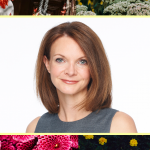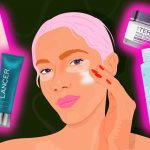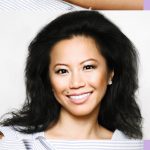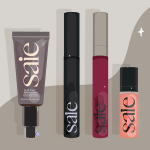So You Want To… Get Amazing Hair
-
Beauty IRL

She's got great hair days down to a science. Dr. Jeni Thomas is a principal scientist at Pantene, where her job includes researching strand textures, working with teams around the world who are innovating hair care ingredients, and helping her industry navigate tough topics like climate change and side parts.
“I want you to know that hair is not biologically active,” says the Texas native. “But that doesn’t mean it’s dead. In fact, hair reacts and responds to energy the same way our emotions do. Hair has so much personality!”
Here’s her advice for fixing split ends, saving your dye job, and understanding the real purpose of common ingredients like silicone. (Which is, apparently, not evil at all? Wow.)
What is our hair actually made of?
There are 2 main components in hair. It’s about 85% to 90% protein. Then you’ve got lipids, pigments, and some metals.
Wait, we all have metal in our hair?
You do! But I mean that technically, as in, you have metal elements from the periodic table. For instance, copper is something that your hair absorbs, especially when you’re swimming. You know how your hair can get green from the pool? Many people believe it’s chlorine, but it’s actually copper that your hair absorbs!
How much can we influence our hair with external products, and how much is diet? How much is genetics?
This is such a great question, because there’s a lot of confusion here. All 3 of those things influence your hair, but at different points of the hair strand’s life. So diet comes to play when a hair strand is newly formed. What’s the size, shape, growth rate—that’s genetics and diet… But once that hair strand emerges from the scalp, and is something that you see on the outside of somebody’s head? Diet won’t do anything… It’s topical products and externally applied products that will really help your hair do what you want it to do.
As a product scientist, what do you think of the clean beauty movement?
Ohhh, I have a lot of thoughts on this! You really want me to tell you what I think? I think as a movement, it’s great because it’s inspired people to really try and become more knowledgeable about the beauty products they’re putting on their body. I think that’s great… The parts of “clean beauty” that I don’t find to be as positive? One, I think it’s a fear-based message. It’s implied that if you’re not using natural products, then what you’re using must be dirty or toxic. That isn’t the case. Also, I don’t find it to be so inclusive, because of the higher price point that generally comes with clean beauty.
What about the science of it?
I find it to be really oversimplified… What often happens is, you’ll take an ingredient like a sulfate. And you’ll treat it like it’s the only ingredient, when really, it’s working with other ingredients so the chemical reaction is completely different! It’s like telling someone to eat a bowl of mustard, instead of using mustard as one ingredient in a marinade. It’s not the same thing! There’s also a lot of what I call “nature baiting.” Just because something is natural doesn’t mean it’s safe or good for your hair. Arsenic is natural! It is also deadly!
How has your job changed because of the climate crisis?
Partly, it goes back to the ‘clean beauty’ question… Because let’s say Pantene were to replace all silicone with coconut oil. I wouldn’t recommend that, by the way! But let’s just say they did, so they could say, “We get all our ingredients from plants.” Well, then you’re depleting a lot of natural resources for an ingredient that isn’t necessary, when there are other harm-free things like silicone that do the job…I’m also always asking, “What’s the energy requirement for this product? What’s the water requirement for it?” Not just dry shampoo, but what else can work that way?
How has your job changed to embrace more ideas of “beautiful hair?” Growing up, I was told frizz was bad. But frizz can look so gorgeous, and people are finally catching on!
Right?! I have curly hair and I know exactly what you mean… You know, if you look back to old hair textbooks, you see hair described as three types: Caucasian hair, hair of Asian descent, hair of African descent. But that’s so untrue; there are so many types of hair… But it’s really only possible to learn about all those types of hair when there’s access to more education for people to learn from each other. So researching as many formulas as possible; talking to as many people as possible about their hair and how it feels, how they want it to look—that’s the best way to do my job.
Help! I want stronger hair. What can I do?
There are some ingredients that work in a way that is really important. The lipids in hair are so important, because they help your hair not break. But we lose those natural lipids from hair dye, from heat styling, from UV exposure. It’s just part of the natural wear and tear of hair! That means conditioning products can help to replenish lipids. And if you want to get science-y about it, ingredients used widely in conditioning products are cetyl and stearyl alcohol, which are creamy emollient ingredients. They can penetrate into the hair fiber and restore hair with lipids so it has that flexible, strong behavior.
What about split ends?
What you really need is to keep that outer protective layer of your hair, the cuticle, complete and intact. You need something that can help reinforce that outer protective layer. Silicone ingredients do this so well. You want to look for aminopropyl dimethyl, because it has a positive charge attached to it. That charge allows it to seek out the weakened parts of the hair fiber, and reinforce that outer structure.
Is there an ingredient we want to use to keep color from fading or changing?
Antioxidants are so important. There’s an amino acid called histidine that can reduce free radicals, which oxidize your hair and have a really bad effect on the pigments.
Okay, so basically, science is magic.
It can be! Especially when you use formulas the right way, it absolutely can be.



